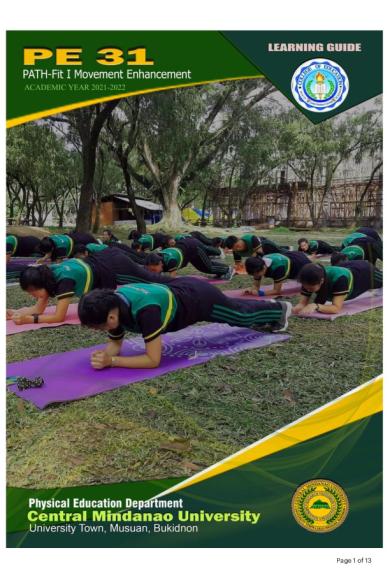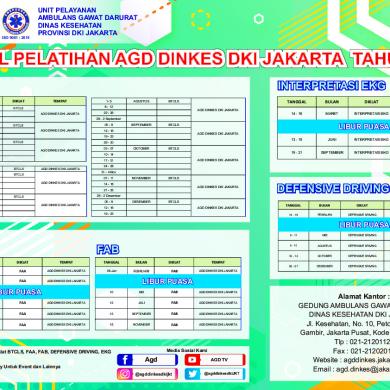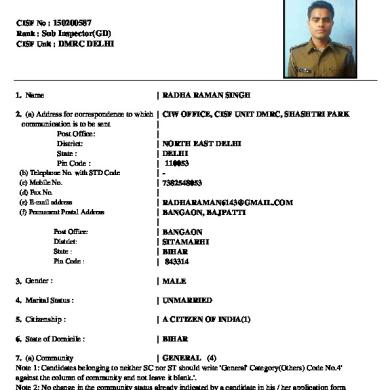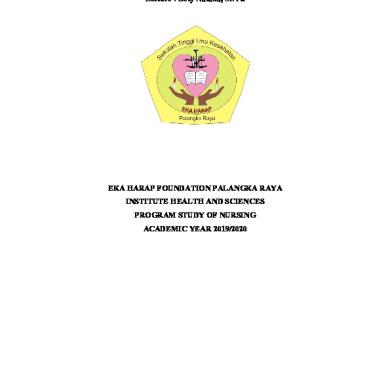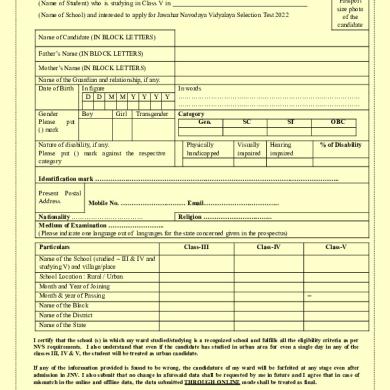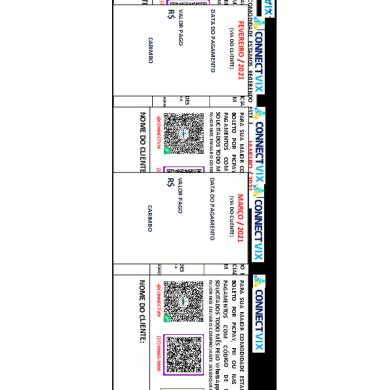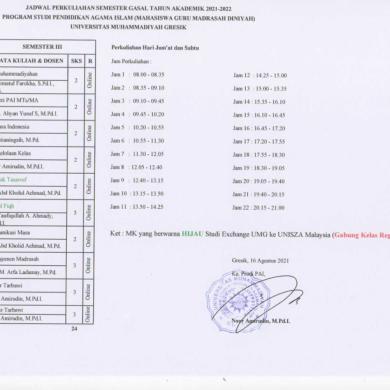Page 1 of 13
Physical Education Department This learning guide is made for education purposes only. This learning guide is free and cannot be reproduced for profit. Educational fair use guideline is observed. Contents of this learning guide is a compilation of information amassed from referenced articles, books, and online sources. If you are the author of the information we have used, please don’t hesitate to contact us.
Physical Education Department Central Mindanao University www.cmu.edu.ph
[email protected]
Page 2 of 13
UNIT 2
THE PHYSICAL FITNESS TEST TIME ALLOTMENT
This learning guide will be discussed for six (6) hours, equivalent to 3 sessions
INTRODUCTION
We have learned about foundational movement patterns and how being competent in these movements improve our capacity to perform physical activities in the previous module. We found out that our inclination to physical activity can be affected by our foundational movement skills or physical literacy. We also identified factors that limit or enhance body movement. We determined that in order to positively improve our movement competency we need to train. However, before undergoing movement enhancement training, we should check your fitness level. So for this unit, we will find out which fitness components are your strengths and which areas should we work on.
LEARNING OBJECTIVES
At the end of this unit the students should have: 1. Conducted and/or participated in a physical fitness test; and, 2. Interpreted their fitness level according to the physical fitness test values.
TOPICS Before we identify the different tests that can determine your physical fitness, let us define a few concepts related to physical fitness. When a person is physically fit, it means that they can perform normal and unexpected demands of everyday living without being too exhausted and still have energy left for recreational and leisure activities. Physical fitness is defined as a set of attributes or characteristics individuals have or achieve that relates to their ability to perform physical activity. The characteristics of physical fitness are usually separated into the health-related and skill-related. Physical activity is defined as any bodily movement made by the contraction of skeletal muscles that results in an expenditure of energy. Examples of physical activity are doing household chores, walking to and from school and/or places, gardening, biking to and from work, playing games, sports, and exercise. Exercise is considered as a type of physical activity which involves repetitive bodily movements that is planned, designed, and structured for the purpose of improving one or more components of physical fitness. Running, pilates, plyometrics, dance aerobics, and strength training are some examples for exercise programs that are carried out on a regular basis. Physical Readiness Questionnaire (PAR-Q) is a seven-item questionnaire that assess your medical and physical readiness. This is done before you begin a regular physical activity program for health and wellness. If you answer YES to any of the questions, you are advised to seek medical consultation before beginning a physical program.
!
STUDENTS IN MODULAR DELIVERY OF LEARNING, PLEASE CONTACT YOUR PROFESSOR OR INSTRUCTOR BEFORE PROCEEDING WITH THE PHYSICAL FITNESS TEST. Page 3 of 13
Note: make sure you have answered the PAR-Q before proceeding with the PFT. Warm-up properly before you begin the physical fitness test. Health Related Components Cardiovascular Endurance: is the ability heart and lungs to supply oxygen to the body during prolonged physical activity. We can exercise for longer periods of time when our cardiovascular system can effectively provide your body with its energy requirements efficiently. To be efficient, your body needs to have a strong heart, healthy lungs and clear blood vessels. Examples of activities that require good cardiovascular endurance are marathon, triathlon, and swimming. How to assess: 3-minute Step Test is a sub-maximal measure of cardiorespiratory endurance. (Corbin, 2014) Before proceeding we need to learn how to get pulse. There are two convenient sites to get your pulse rate : a.Carotid pulse: using your index and middle finger, locate the end of your jaw. Now slide your fingers downward diagonally (around an inch) towards the middle of your neck. Before you reach the middle of your neck, stop. When you feel a beat pushing against your fingertips, you have found your carotid pulse. Caution: Don’t press too hard on your neck or this might affect your pulse rate. Also, if you’re using your right hand, find your pulse on the right side of your body, or vice versa (see FIG. 2.1.(a)).
Photo: Prof. Procopio B. Galendez, Jr. a. Carotid pulse; b: FIG. 2.1. a) b) radial pulse
Equipment needed: A stopwatch, 12-inch high bench, 96 bpm metronome (can be played on speaker from youtube) Procedure: 1. Use a bench that is 12 inches high. Step up with your right foot. Step up with your left foot (See FIG. 2.2). 2. Step down with your right foot. Step down with your left foot. 3. Repeat this four-count pattern (up, up, down, down). Step 24 times each minute for three minutes or in time to the metronome set at 96 bpm. 4. Immediately after stepping for three minutes, count your pulse. Begin counting within 5 seconds. Count for 10 seconds. Multiply the pulse by 6. This is your exercise pulse rate. Record it as your score in the PFT SCORE CARD 5. Rest for 3 minutes. Sit down and avoid large movements. Once three minutes is done, immediately get your recovery heart rate. Write on your PFT SCORE CARD.
Photo: Prof. Procopio B. Galendez, Jr.
b.Radial pulse: from the middle of your wrist, slide both your middle and index fingers slightly (approximately half an inch) towards your thumb. Once you feel a gentle throb pushing against your fingertips, you have located you radial pulse site (se FIG 2.1.(b)).
FIG. 2.2. Step Test Page 4 of 13
6. Use the table 1 to determine your cardio respiratory endurance rating. *students who cannot step for 3 minutes receive a low fitness rating
Table 1. Rating Chart: Step Test (pulserate per minute) 17 Years Old and Older Rating
Male
Female
High Performance
≤80
≤90
Good Fitness
81-90
90-100
Marginal Fitness
91-110
101-120
≥111
≥121
Low Fitness Data based on Fitnessgram, (Corbin, 2014)
Muscle Strength: The ability of muscle to exert force. It is often measured by how much weight you can lift or how much resistance you can overcome. Examples of activities that require good strength are lifting a heavy weight or pushing a heavy box.
How to assess: Curl up is a test for abdominal muscle strength and muscular endurance. This test records the maximum numbers of curl ups a person can do in one-minute. Equipment needed: a fitness mat or carpet 1.
2. 3. 4. 5.
6.
a) preparatory/end phase
b) execution phase
Photo: Prof. Procopio B. Galendez, Jr.
Muscle Endurance: The ability of muscle to continue to perform without fatigue. It is the ability to use your muscles many times without tiring. Examples are doing many curl-ups or push-ups or maintaining a plank position for a long time.
Procedure: Lie on your back on a mat or carpet. Bend your knees. The distance between your heel and buttocks should be FIG.2.3 Curl-Up Test around 12 inches. Your feet on the floor and palms on your thighs. (See FIG 2.3.a.) Keeping your heels on the floor, curl your shoulders up and slide your hands forward so that your palms move towards your knees. Curl up until your hands cover your entire knee. (See FIG 2.3.b.) Slowly lower your back until your head rests on the mat. Table 2. Rating Chart: Curl-Up (Number of Repeat the curl-up procedure, counting whenever you lower your back on the mat. 15 Years Old and Older You are finished if you can’t do another curlRating Male Female up before the set time or your form breaks and/or set pace cannot be kept. High Performance ≤48 ≤36 Form breaks when: Good Fitness 24-47 18-35 Feet comes off the ground Marginal Fitness 20-23 15-17 Cadence is not kept. Palms cannot cup the knees anymore. Low Fitness ≤19 ≤14 Hands slide one after the other. Data based on Fitnessgram, Corbin (2014) Record the number of curl-ups you completed, then find your rating in table 2.
• • • •
Page 5 of 13
Push-up is a test for upper body strength and muscular endurance. This test records the maximum numbers of push-ups a person can do in one minute. (Corbin, 2014)
2.
3.
4. 5. 6.
Photo: Prof. Procopio B. Galendez, Jr.
1.
Equipment needed: fitness mat/ carpet Procedure:. Lie facedown on the mat with your hands (palm down) under your shoulders, your finger spread, and your legs straight. Your legs should be slightly apart and your toes tucked under (see FIG.2.4.(a)). For women (see FIG.2.4.(b)), assume the “modified push up” position (legs, together, lower leg in contact with the mat, knees as the pivotal point). Push up until your arms are straight. Your body should form a straight line from your head to your heels (or FIG 2.4. a) Push-up (for men), b) modified push-up for women knees for women). Lower your body by bending your elbows Table 3. Rating Chart: Push-Up (Number of Repetitions) until your upper arms are parallel to the 16 Years Old and Older floor (elbows at a 90-degree angle), then push-up until your arms are fully Rating Male Female extended. High Performance ≥36 ≥16 Repeat the push-up procedure, counting whenever you lower your body to the Good Fitness 18-35 7-15 floor. Marginal Fitness 16-17 6 You are finished if you can’t do another push-up before the set time or your form Low Fitness ≤15 ≤5 breaks and set pace cannot be kept. Data based on Fitnessgram Use the table 3 to determine your pushup rating.
Flexibility is the range of motion available at a joint. It is the ability to use your joints fully through a wide range of motion without injury. You are flexible when your muscles are long enough and your joints are free enough to allow adequate movement. Examples of people with good flexibility include ballet dancers and gymnasts.
Photo: Prof. Procopio B. Galendez, Jr.
How to assess: Sit and Reach Test is a functional measure of hip region flexibility, including the lower back and the hamstring muscles. (Parker, 2019) Before you start the test, makes sure your warm-up includes light stretching. Equipment needed: Tape measure and adhesive tape Procedure: 1. Place the measuring tape on the floor. Find the 23Sit and Reach Test Reach Test FIG.2.4 Sit and
Page 6 of 13
centimeter mark. Place an adhesive tape along that 23 cm mark. You can either wear your socks or be barefoot. 2. Sit down on the floor with the tape in between your legs with the heels of your feet along tape at the 23 cm mark. Point your toes up and keep your knees straight. Your feet should be 12 inches (1 ruler) width apart. 3. Put your hands on top of each other then slowly bend forward, reaching as far as possible along the measuring tape. Once you’ve reached as far as you can, hold that position for two seconds. 4. Record the greatest length achieved to the nearest centimeter. Record the best score out of three attempts. Table 4. Rating Chart: Sit and Reach (cm)
17 -19Old
20-29 years old
Rating
Male
Female
Male
Female
High Performance
≥27
≥30
≥33
≥35
Good Fitness
22-26.9
26-29.9
28-32.9
31-34.9
17.1-21.9
17-25.9
23-27.0
26-39.9
≤16.9
≤16.9
≤22.9
≤25.9
Marginal Fitness Low Fitness Data based on Parker (2019)
5. Use the table 4 to determine your flexibility rating.
Photo: Prof. Procopio B. Galendez, Jr.
Body Composition: The relative amounts of muscle, fat, bone, and other vital parts of the body. It refers to the different types of tissues that make up your body, including fat, muscle, bone, and organ. Your level of body fat is often used to assess the component of body composition related to health. Body composition measures commonly used in schools include body mass index (based on height and weight), skinfold measures (which estimates body fatness), and body measurements such as waist and hip circumferences. How to assess: Body Mass Index (BMI): an index that uses a body’s height and weight to determine the thinness or excessive fatness of the body. (Corbin, 2014) Equipment needed: weighing scale, tape measure
Proper way of measuring your height
FIG 2.6. Proper way of measuring your height
Procedure: 1. Measure your height in inches (or meters) without shoes. How to measure your height: Find a wall to stand against on. Make sure that the floor is flat and level. Stand with your back against the wall. Your heel, buttocks, shoulders and head should be touching the wall. Look ahead. Have someone place a flat material (i.e., hardbound book) on top of your head. With the flat material pressed against the wall, duck and slowly get out of the way. Ask that someone mark the bottom of the flat material. Lastly, run the measuring tape from the floor to where the mark is, making sure that it is straight. 2. Measure your weight in pounds (or kilograms) without shoes. How to measure your weight: Make sure your weighing scale is calibrated (with the dial on 0 kg mark) With shoes off, step both of your feet on the weighing scale with hands on the side. Look straight. Have someone read your weight. You don’t have a weighing scale at your home? Check if your Barangay clinic has one. Please follow safety protocols. 1. Calculate your BMI using the formula given (see Fig.2.7). FIG 2.7. Formula for BMI
Page 7 of 13
Table 5 . Rating Chart: BMI
BMI
Category
<18.5
Underweight
18.5-21.99
Acceptable
22.0-24.99
Acceptable
25.0-29.99
Overweight
30.0-34.99
Obese I
35.0-39.99
Obese II
40.00
Obese II
Table 6 . Rating Chart: Waist to Hip Ratio
BMI
Male
Female
Good Fitness Zone (Low Risk)
≤0.90
≤0.79
0.91-1.00
0.80-.85
≥1.1
≥0.86
Marginal (Moderately High Risk Low Fitness Zone (High Risk) Data from Corbin, Le Masurier, & McConell, (2014)
Data from Corbin, Le Masurier, & McConell, (2014)
2. Use table 5 to find your BMI rating. Record you BMI Score and rating. Waist to Hip Ratio: is a measurement used to assess health risk. People who carry more weight in the middle of the body have a higher risk of disease than people who carry more weight in the lower body (legs and hips). (Corbin, 2014) Equipment needed: tape measure
2.
3. 4.
Photo: Prof. Procopio B. Galendez, Jr.
1.
Procedure: Measure your hips at the largest point (roundest part of your buttocks) (see FIG 2.8. (a)). Make sure that the tape is at the same level. Tape should be snug but not so tight as to cause indentations in your skin. Stand with your feet together. M e a s u re yo u r wa i s t a t t h e s m a l l e s t circumference (see FIG 2.8.(b)). If there is no natural waist, measure at the level of the umbilicus. Measure at the end of a normal inspiration. Do not suck to make your waist smaller. To calculate your waist to hip ratio, divide your waist circumference by your hip FIG 2.8. a) hip circumference; b) waist circumference circumference. Find your ratio in table 6 to determine your rating.
Skill Related Components Power: The ability or rate at which one can perform work. It is the ability to use strength quickly; thus it involves both strength and speed. It is sometimes referred to as explosive strength. People with good power can, for example, jump far or high, throw a ball far and swing fast. How to assess: For Leg Power: Vertical Jump Height Test or Sargent Jump Test (see: https://www.brianmac.co.uk/ sgtjump.htm for more details) Agility: The ability to change the position of the body in space with speed and accuracy. It is the ability to change the position of your body quickly and control your body’s movements. People with good agility are likely to be good, for example, at wrestling, diving, soccer, and basketball. How to assess: Page 8 of 13
For Change of Directio: Illinois illinois.htm)
Agility Test (see: https://www.topendsports.com/testing/tests/
Balance: The maintenance of equilibrium while stationary or moving. It is the ability to keep an upright position while standing still or moving. People with good balance are likely to be good, for example, at gymnastics and ice skating. How to assess: For Static Balance: Stork Balance Test (see: https://www.topendsports.com/testing/tests/balancestork.htm) Speed: The ability to perform a movement within a short period of time or cover a distance in a short period of time. For example, people with good leg speed can run fast, and people with good arm speed can throw fast or hit a ball that is thrown fast. How to assess: For Running Speed: 20 Meter Dash (see: https://www.topendsports.com/testing/tests/ sprint-20meters.htm) Coordination: The ability to use the senses, such as sight and hearing, together with body parts in performing tasks smoothly and accurately. People with good eye-hand or eye-foot coordination are good at juggling and at hitting and kicking games such as soccer, baseball, volleyball, tennis, and golf. How to assess: For Hand-Eye Coordination: Stick Flip Coordination Test (see: https://www.topendsports.com/ testing/tests/stick-flip.htm) Reaction Time: The time elapsed between stimulation and the beginning of the reaction to it.it is the amount of time it takes you to move once you recognize the need to act. People with good reaction time can make fast start in track and swimming and can dodge fast attacks in fencing and taekwondo. How to assess: Red Light-Green Light Reaction Time Test (play it online! See: https:// faculty.washington.edu/chudler/java/redgreen.html) *Skill-related physical fitness rating categories describe the levels of performance ability of a person and not their health and wellness.
REFERENCES
a) American College of Sports Science (2014). ACSM’s Guidelines for Exercise Testing and Prescription. Lippincott Williams and Wilkins, Baltimore:MD. b) Corbin, C. B., Le Masurier, G. C., & McConell, K. E. (2014) Fitness for Life. Human Kinetics, Champaign:IL. c) Corbin, C. B., Welk, G. J., Corbin, W. R., and Welk, K. A. (2013) Concepts of Fitness and Wellness: A Comprehensive Lifestyle Approach, 10th Edition. McGraw-Hill, New York:NY. d) Hoeger, W. W., & Hoeger, S. A. (2011). Fitness & Wellness. Wadsworth, Belmont:CA. e) Parker, R. (2019). How to test flexibility and balance. Retrieved: https://humankinetics.me/ 2019/09/13/how-to-test-flexibility-and-balance/
Page 9 of 13
LEARNING ACTIVITIES /ASSESSMENT PHYSICAL FITNESS TEST SCORE CARD PERSONAL PROFILE Name:
Age:
Sex:
Section
Class Schedule:
HEALTH RELATED COMPONENTS OF PHYSICAL FITNESS Cardiovascular Endurance Test: 3-Minute Step Test
Heart Rate Before Exercise: ___________
Recovery Heart Rate: ___________
Exercise Heart Rate: _____________
Category: _________
Photo Evidence:
Muscular Endurance Test: Push Up: Number of Repetitions:
Category:
Curl Up: Number of Repetitions:
Category:
Photo Evidence:
Page 10 of 13
Flexibility Best Attempt: ________ (cm)
Category:
Photo Evidence:
Body ComposiHon Body Mass Index: Height: ______ (m)
Weight: ______ (kg)
BMI:
Category: __________________
_________
Waist to Hip Ratio: Waist Circumference: _________ (cm)
Hip Circumference: _______ (cm)
W-H Ratio: _________
Category:
Photo Evidence of Measurement:
Photo Evidence of Calculation:
Name of Tester:
Signature of Tester:
Date: Page 11 of 13
Per Exercise: (6 exercises)
Total points: 90
GENERAL SCORING RUBRIC FOR PHYSICAL FITNESS TEST POINTS Outstanding
15
Satisfactory
11
Unsatisfactory
8
Needs Improvement
4
CRITERIA The photo evidence showed the student correctly executing the test and with the proper form. The student recorded and interpreted the result correctly. The student was on a fitness mat (or acceptable alternative) and wearing complete PE attire/ uniform.. The photo evidence showed the student performing a slight deviation on the proper form of the test. The student recorded and interpreted the result correctly. The student was on a fitness mat (or acceptable alternative) and wearing complete PE attire/ uniform. The photo evidence showed the student performing a noticeable deviation on the proper form of the test. The student recorded a result but misinterpreted the values. The student was on a fitness mat (or acceptable alternative) and was missing a required prescription for a complete PE attire/Uniform. The photo evidence showed the student incorrectly performing the proper form of the test. The student recorded an incorrect result leading to an incorrect interpretation. The student was on a fitness mat (or acceptable alternative) and was not wearing the required PE attire/Uniform.
Form
Total points: 10 Score
Outstanding 10 Satisfactory
7
Unsatisfactory 5 Needs Improvement 3
Criteria Form is duly filled. All necessary information is answered and clearly organized. Form is filled-out however there are 1-2 missing information. Form is filled-out however there are 3-4 missing information, pictures provided are blurry and/or overlap each other or the text. Form is filled-out however there are more than 5 missing information, pictures provided are blurry and/or overlap each other or the text. Page 12 of 13
Page 13 of 13
